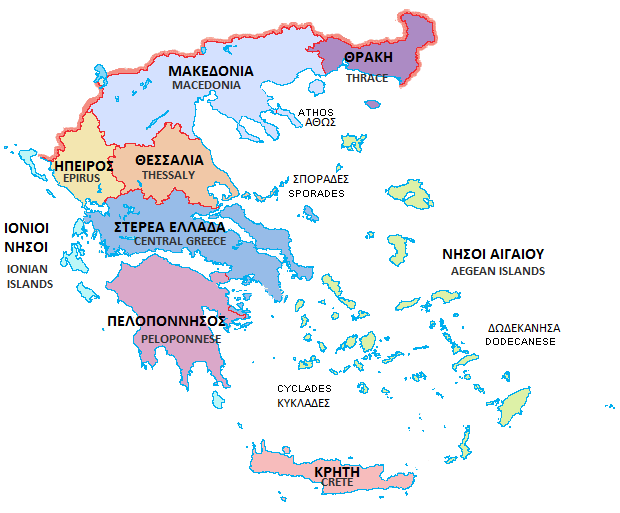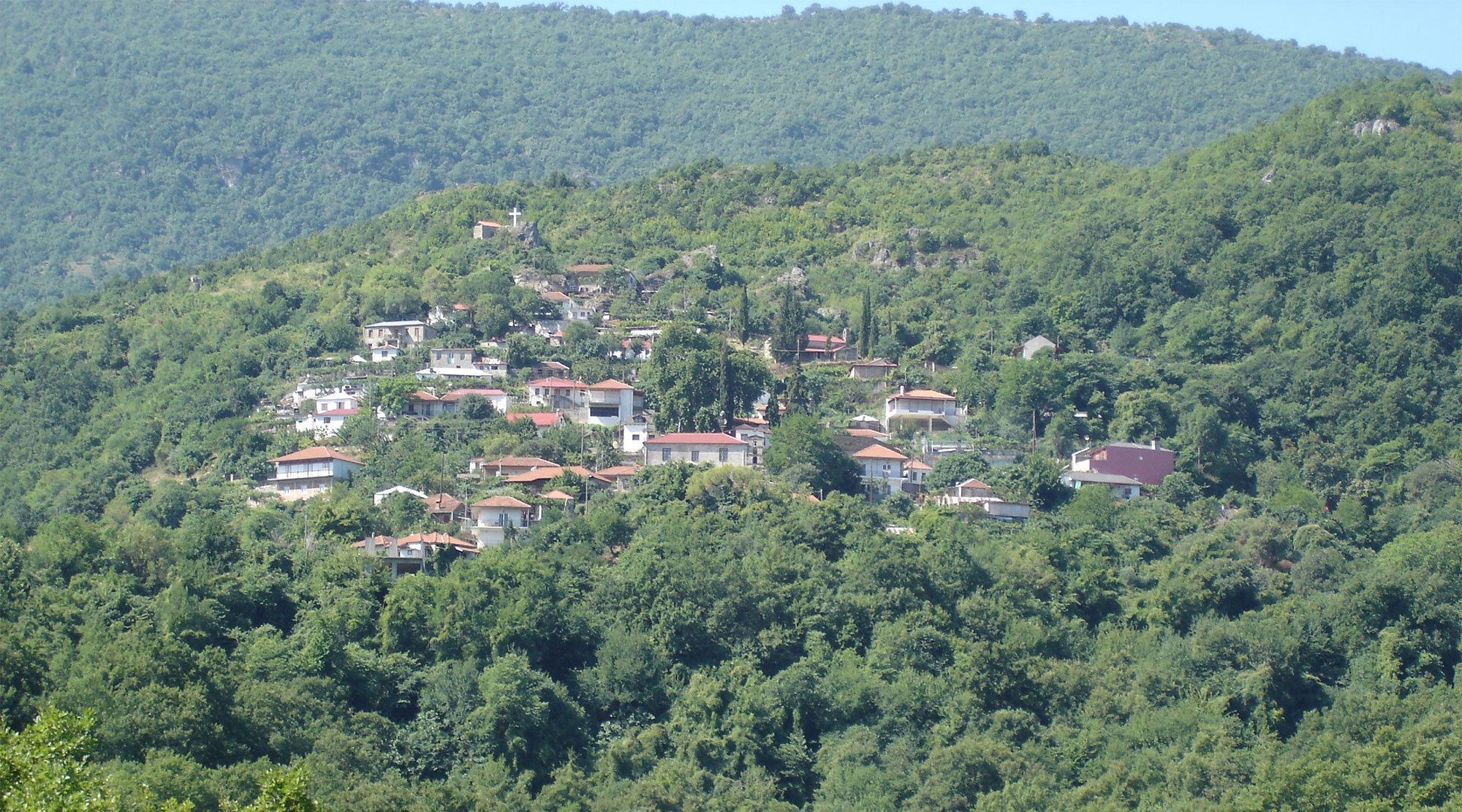Τάι-Τάι
(Greece)
|
Song title: Τάι-τάι (transliteration: Tai-Tai)
Lyrics: Greek folk songs
Composer: Greek folk song
Singer: many singers
Dance name: Same song title
Choreographer: Traditional dance from Thessaly region in Greece
Folk Dance Music: The 5th Asian Folk Dance Camp
The Chinese name of this dance is a transliteration from the original name. It’s not really what we mean by the husband’s wife. This dance comes from Greece.
The Thessaly Region (Θεσσαλία) equivalent of a State in the US, in the northern part of central Greece. the dance name Τάι-τάι is the abbreviation of τ αϊνέβαινε in the local dialect, it means climbing or climbing mountains.
Θεσσαλία(Thessaly):

This dance comes from the annual Easter event in the village of Αϊδονοχώρι in Thessalia, Greece, and is the last dance in the event.
Αϊδονοχώρι:


The way to calculate Easter has been slightly different in different rigious branch but the difference is within a few days. The Easter of Greek Orthodoxy (Orthodox Christianity) is 1 to 2 weeks later than other religions.
Note from Frog: Easter is a festival commemorating the resurrection of Jesus on the third day after he was crucified on the cross. It was first set on the Jewish Passover (Nisan 14th in the Jewish calendar). Western churches including Rome, later regarded Jesus resurrection on Sunday as the day of the Jewish Passover and the first Sunday after Passover was Easter. In the fourth century, 325 AD, during the Byzantine Empire era, the Roman Emperor Constantine I held the first Council of Nicaea and decided to abandon Jewish calendar. Easter is changed to the first Sunday after the full moon of the vernal equinox each year. After the vernal equinox, the northern hemisphere begins to have longer days and shorter nights, and the light is greater than the darkness. Even the dark nights are illuminated by the moon.
The calculation of Greek Orthodox Easter is different, and the commemoration period lasts for 40 days. Easter is the first Sunday after the full moon passes March 21 every year except if the full moon happens on Sunday. Easter will be the following Sunday if the full moon falls on a Sunday. Clean Monday, when the Greek Orthodox resurrection fasting event begins, is 40 days before the Greek Easter. During the fasting period, they are not allowed to eat beef, sheep, chicken, and can only eat fruits, vegetables, and fish. The exception for fish should come from Jesus giving five loaves and two fish. The last three days of the fasting period start from Friday to Easter, the entire commemorative ceremony and activities are similar to the Easter activities of other religions.
Because the calculations are different, following table shows the Easter day for various Western religions in the past ten years:
Table of (Gregorian) dates of Easter 2015–2030
|
|
Year
|
Full Moon
|
Jewish Passover
|
Astronomical Easter
|
Gregorian Easter
|
Julian Easter
|
| | | | | |
|
2015
|
4 April
|
5 April
|
12 April
|
|
2016
|
23 March
|
23 April
|
27 March
|
1 May
|
|
2017
|
11 April
|
16 April
|
|
2018
|
31 March
|
1 April
|
8 April
|
|
2019
|
20 March
|
20 April
|
24 March
|
21 April
|
28 April
|
|
2020
|
8 April
|
9 April
|
12 April
|
19 April
|
|
2021
|
28 March
|
4 April
|
2 May
|
|
2022
|
16 April
|
17 April
|
24 April
|
|
2023
|
6 April
|
9 April
|
16 April
|
|
2024
|
25 March
|
23 April
|
31 March
|
5 May
|
|
2025
|
13 April
|
20 April
|
|
2026
|
3 April
|
2 April
|
5 April
|
12 April
|
|
2027
|
22 March
|
22 April
|
28 March
|
2 May
|
|
2028
|
9 April
|
11 April
|
16 April
|
|
2029
|
29 March
|
31 March
|
1 April
|
8 April
|
|
2030
|
17 April
|
18 April
|
21 April
|
28 April
|
Night of Good Friday, the Friday before Easter Sunday, is the day Jesus died on the cross. Greeks will bring their whole families to the church on Good Friday. The church is decorated with flower arrangements and sacrificial supplies. Everyone will hold a candle and follow the coffin of the priest and Jesus and will walk around the streets to express condolences for the death of Jesus after the priests prayer ceremony is completed.
According to the Bible, Jesus was resurrected at 12:00AM midnight on Holy Saturday. The Greeks once again went to the church to celebrate with their families, setting off firecrackers and fireworks, and then it was dinner time on that day. The Greek Orthodox Christians were once allowed to have non-vegetarian meat. Dinners main dish is "Sheep liver porridge" Μαγειρίτσα (pronounced Magiritsa) or haggis porridge. This porridge is to warm up the spleen and stomach to avoid the possibility of indigestion after the end of a 40 days fasting period. The next day on Easter Sunday, the Greeks prepared whole roast lambs, similar to Chinese roasted suckling pigs, the whole lamb was skewered and roasted. The internal organs would be removed when roasting the lamb. All edibles such as liver are saved and to be used as an ingredient for lamb liver porridge.
Magiritsa (Μαγειριτσα):

There are two charcoal fireplaces when roasting lamb: the first to burn wood turning it to red-hot charcoal chips then move the chips to the 2nd fireplace. The lamb is roasting on the high temperature fireplace for 6-7 hours from 7 AM to 2 PM. However, nowadays not too many devout Greek Orthodox Christians. Fewer people can really observe the 40-day fasting period. Most people only fast for a week before Easter, and many people ignored the fasting period altogether and continued to eat chicken, duck and beef.
Charcoal-roasted lamb:

In addition to the charcoal-roasted lamb, another interesting Greek tradition on Easter is "cracking red eggs." The Greek Easter eggs are not painted into colorful eggs like in the United States. They are more like Chinese Red Eggs to celebrate when a boy is 1 month old after birth. The entire eggs are painted in red, symbolizing the blood of Jesus. In Greece, red eggs are cracked during lunch on Easter. Everyone will have a red egg, and then they will find another person to crack each others red eggs. Each person has two chances. The first time is to knock each other with eggs sharper tip, and the second time is with the blunt end. The person whose egg is not broken after the two knocks wins and can compete with the winners of other groups. The last winner means that he or she will have good luck this year.
Crack each others red eggs:

Last dance in the event:


Original Greek lyrics:
1.
Της Αλεξάνδρας το ι βρε το ι βουνό
κανείς δεν τ αϊνεβαίνει.
Της Αλεξάνδρας το ι βρε το ι βουνό
κανείς δεν τ αηνεβαίνει.
(chor 1).
Κι η κόρη αΐ που τάι τάι
μωρέ προς μωρέ βι τι τι
κι η κόρη αΐ που τ αηνεβαίνε.
Κι η κόρη αΐ που τάι τάι
μωρέ προς μωρέ βι τι τι
κι η κόρη αΐ που τ αηνεβαίνε.
2.
Αϊντέ κι η κόρη αΐ που τα αηνηβαίνε
πλεγώ, πλεγώντας το γαϊτάνι.
Αϊντέ κι η κόρη αΐ που τα αηνηβαίνε
πλεγώ, πλεγώντας το γαϊτάνι.
(chor 2).
Πλεγώντας μωρ τάι τάι
μωρέ προς μωρέ βι τι τι
πλεγώντας κι αναπλεγώντας.
Πλεγώντας μωρ τάι τάι
μωρέ προς μωρέ βι τι τι
πλεγώντας κι αναπλεγώντας.
3.
Αϊντέ πλεγώντας κι αναπλε, αναπλεγώντας
και ψι και ψιλοτραγουδώντας.
Αϊντέ πλεγώντας κι αναπλε, αναπλεγώντας
και ψι και ψιλοτραγουδώντας.
(chor 3).
Πλεγώντας μωρ τάι τάι
μωρέ προς μωρέ βι τι τι
πλεγώντας κι αναπλεγώντας.
Πλεγώντας μωρ τάι τάι
μωρέ προς μωρέ βι τι τι
πλεγώντας κι αναπλεγώντας.
References:
1. Wikipedia-Greece edition
2. Greek Dance Encyclopedia
3. Wikipedia-English edition
4. Let’s Dance monthly,1990,December
5.Greec Primary School Education website: https://paroutsas.jmc.gr
6. Akilalin’s blog at Pixnet.net


 字體:小 中 大
字體:小 中 大

 字體:小 中 大
字體:小 中 大